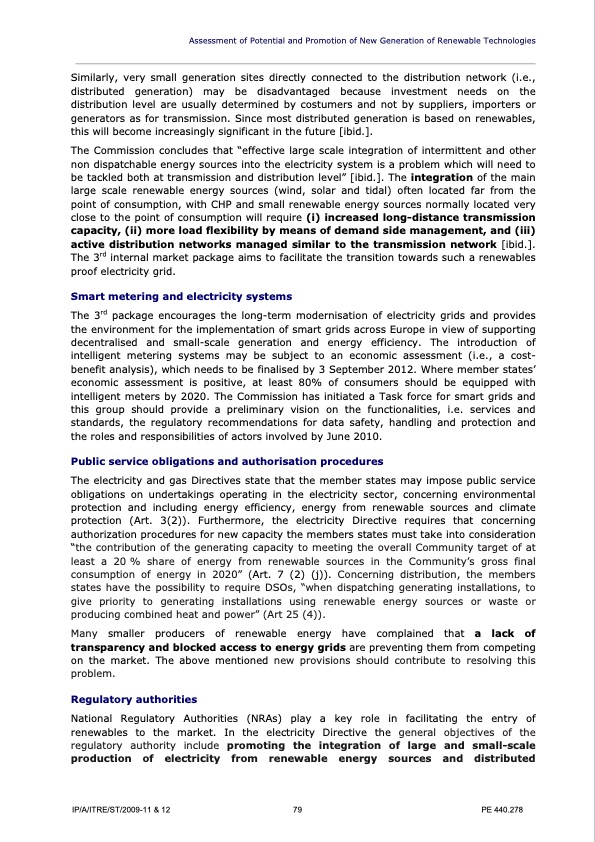
PDF Publication Title:
Text from PDF Page: 103
Assessment of Potential and Promotion of New Generation of Renewable Technologies ____________________________________________________________________________________________ Similarly, very small generation sites directly connected to the distribution network (i.e., distributed generation) may be disadvantaged because investment needs on the distribution level are usually determined by costumers and not by suppliers, importers or generators as for transmission. Since most distributed generation is based on renewables, this will become increasingly significant in the future [ibid.]. The Commission concludes that “effective large scale integration of intermittent and other non dispatchable energy sources into the electricity system is a problem which will need to be tackled both at transmission and distribution level” [ibid.]. The integration of the main large scale renewable energy sources (wind, solar and tidal) often located far from the point of consumption, with CHP and small renewable energy sources normally located very close to the point of consumption will require (i) increased long-distance transmission capacity, (ii) more load flexibility by means of demand side management, and (iii) active distribution networks managed similar to the transmission network [ibid.]. The 3rd internal market package aims to facilitate the transition towards such a renewables proof electricity grid. Smart metering and electricity systems The 3rd package encourages the long-term modernisation of electricity grids and provides the environment for the implementation of smart grids across Europe in view of supporting decentralised and small-scale generation and energy efficiency. The introduction of intelligent metering systems may be subject to an economic assessment (i.e., a cost- benefit analysis), which needs to be finalised by 3 September 2012. Where member states’ economic assessment is positive, at least 80% of consumers should be equipped with intelligent meters by 2020. The Commission has initiated a Task force for smart grids and this group should provide a preliminary vision on the functionalities, i.e. services and standards, the regulatory recommendations for data safety, handling and protection and the roles and responsibilities of actors involved by June 2010. Public service obligations and authorisation procedures The electricity and gas Directives state that the member states may impose public service obligations on undertakings operating in the electricity sector, concerning environmental protection and including energy efficiency, energy from renewable sources and climate protection (Art. 3(2)). Furthermore, the electricity Directive requires that concerning authorization procedures for new capacity the members states must take into consideration “the contribution of the generating capacity to meeting the overall Community target of at least a 20 % share of energy from renewable sources in the Community’s gross final consumption of energy in 2020” (Art. 7 (2) (j)). Concerning distribution, the members states have the possibility to require DSOs, “when dispatching generating installations, to give priority to generating installations using renewable energy sources or waste or producing combined heat and power” (Art 25 (4)). Many smaller producers of renewable energy have complained that a lack of transparency and blocked access to energy grids are preventing them from competing on the market. The above mentioned new provisions should contribute to resolving this problem. Regulatory authorities National Regulatory Authorities (NRAs) play a key role in facilitating the entry of renewables to the market. In the electricity Directive the general objectives of the regulatory authority include promoting the integration of large and small-scale production of electricity from renewable energy sources and distributed IP/A/ITRE/ST/2009-11 & 12 79 PE 440.278PDF Image | Policy Department Renewable Technologies

PDF Search Title:
Policy Department Renewable TechnologiesOriginal File Name Searched:
IPOL_ITRE_ET(2010)440278_EN.pdfDIY PDF Search: Google It | Yahoo | Bing
NFT (Non Fungible Token): Buy our tech, design, development or system NFT and become part of our tech NFT network... More Info
IT XR Project Redstone NFT Available for Sale: NFT for high tech turbine design with one part 3D printed counter-rotating energy turbine. Be part of the future with this NFT. Can be bought and sold but only one design NFT exists. Royalties go to the developer (Infinity) to keep enhancing design and applications... More Info
Infinity Turbine IT XR Project Redstone Design: NFT for sale... NFT for high tech turbine design with one part 3D printed counter-rotating energy turbine. Includes all rights to this turbine design, including license for Fluid Handling Block I and II for the turbine assembly and housing. The NFT includes the blueprints (cad/cam), revenue streams, and all future development of the IT XR Project Redstone... More Info
Infinity Turbine ROT Radial Outflow Turbine 24 Design and Worldwide Rights: NFT for sale... NFT for the ROT 24 energy turbine. Be part of the future with this NFT. This design can be bought and sold but only one design NFT exists. You may manufacture the unit, or get the revenues from its sale from Infinity Turbine. Royalties go to the developer (Infinity) to keep enhancing design and applications... More Info
Infinity Supercritical CO2 10 Liter Extractor Design and Worldwide Rights: The Infinity Supercritical 10L CO2 extractor is for botanical oil extraction, which is rich in terpenes and can produce shelf ready full spectrum oil. With over 5 years of development, this industry leader mature extractor machine has been sold since 2015 and is part of many profitable businesses. The process can also be used for electrowinning, e-waste recycling, and lithium battery recycling, gold mining electronic wastes, precious metals. CO2 can also be used in a reverse fuel cell with nafion to make a gas-to-liquids fuel, such as methanol, ethanol and butanol or ethylene. Supercritical CO2 has also been used for treating nafion to make it more effective catalyst. This NFT is for the purchase of worldwide rights which includes the design. More Info
NFT (Non Fungible Token): Buy our tech, design, development or system NFT and become part of our tech NFT network... More Info
Infinity Turbine Products: Special for this month, any plans are $10,000 for complete Cad/Cam blueprints. License is for one build. Try before you buy a production license. May pay by Bitcoin or other Crypto. Products Page... More Info
| CONTACT TEL: 608-238-6001 Email: greg@infinityturbine.com | RSS | AMP |